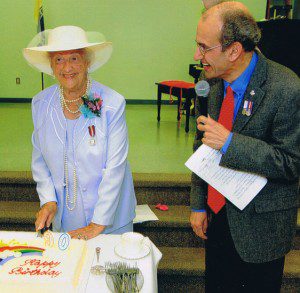
The event was coming to its climax. Guests were assembled. Speeches from dignitaries, family and friends were in the books. We had even sung “Happy Birthday” to the birthday girl. All we had left was to present the cake and candles to her, invite her to make a wish and watch her cut the cake. But there was a problem. Nobody had a way to light the candles. No problem, I thought, I’ll ask the audience.
“Anybody got a light?” I asked. And I looked out at a sea of faces expecting a smoker or a boy scout to come forward.
But nobody moved. Not one person had either a lighter or a book of matches to offer. If any group might be expected to have one or the other in its pockets, for sure, I thought, this one would.
On Sunday we celebrated the 90th birthday of my neighbour, Ronnie Egan at the Uxbridge Seniors’ Centre. So I guessed, for sure, somebody in this gathering of farm families, seniors, city slickers, outdoor types and, maybe, diehard smokers would have a light. But not one.
“How times have changed,” I thought. There would have been a time not so long ago when everybody in that audience had a light.
In contrast, the next night, this past Monday, I drove up to Georgian Bay to speak at the public library in Midland, Ont. In honour, of this week’s 96th anniversary of the Battle at Vimy Ridge, I was speaking and showing visuals about the Canadians who had captured Vimy Ridge from German troops who had been entrenched there since the beginning of the war in 1914. At one point in my presentation, I showed pictures of Canadian troops placing timbers across roads so that horse-drawn wagons and trucks could more easily move equipment forward to the front lines for the battle on April 9, 1917.
“And here,” I said, “the troops are resorting to a little-known Canadian tradition in road building…” I never completed the sentence. A bunch of voices in my audience did.
“Corduroy roads!” they all chimed in.
“What an intelligent group,” I said. Knowledge of corduroy roads, I would have thought, might be as scarce at a public speaking event, as matches and smokers had been at Ronnie Egan’s birthday party the day before. But no. Many of my public library audience not only knew what corduroy roads were, but they also weren’t the least bit bashful about letting me know.
Audiences always surprise. What they know, or don’t. What they have in their pockets, or don’t. Not so long ago, I spoke to an audience of Grade 10 history students who were preparing to go overseas, coincidentally to Vimy and Normandy. During my talk, just before they left, I took a moment to applaud them and their extraordinary capacity to raise funds for their extracurricular trips. I talked about the car washes, the bake sales, the chocolate-covered almond bar sales they must have organized to finance their trip.
“You are amazing when it comes to raising money,” I told them.
But there were no heads nodding in agreement. This was a different group of young people. These kids had had their way to Europe paid for by their parents. These students were members of a private school. They had probably never washed a car or baked a cake to raise cash in their lives. Not because they’d refused to, but because they’d never had to.
Another time, I travelled up to Grey County, I thought, to speak to a couple of history classes at an Owen Sound high school. Well, I guess word had spread and the students had lobbied to get out of class. So, by the time I arrived, the entire student body had assembled in the gymnasium for my talk about D-Day. But there was a problem.
“I’m sorry, sir,” this boy in charge of the public address system said to me. “I can’t make this PA work.”
My heart sank. There I was surrounded by 400-500 hyper-active young people, expected to entertain and I didn’t even have the advantage of a microphone and speaker. Oh well, I set up my projector, pointed it at the blank cinder-block wall, gathered the students – theatre-in-the-round style – around me and belted out my stories as best I could without yelling. With images of young Canadian sailors, airmen and soldiers on D-Day, I drew them into my stories…for about 60 minutes. When I finished, the students applauded and left. Then, their teachers gave me feedback.
“Do you realize what just happened?” they said. “This group has dozens of ADHD (attention deficit disorder) kids in it. They normally don’t sit still for five minutes. You kept them engaged for an hour.”
I counted my lucky stars and chalked it up to another audience just full of surprises.